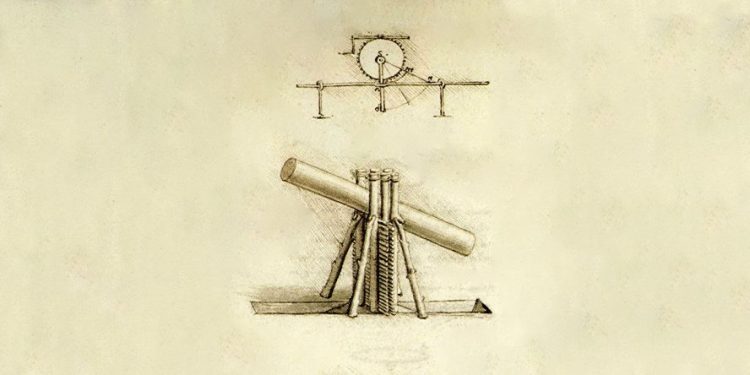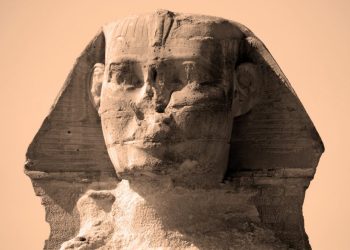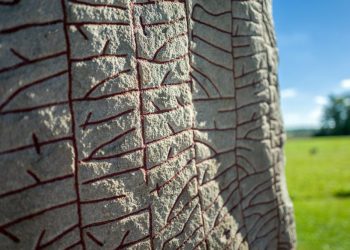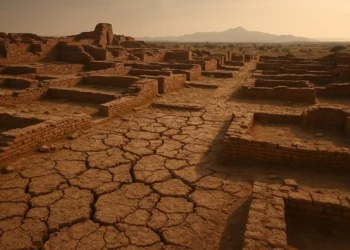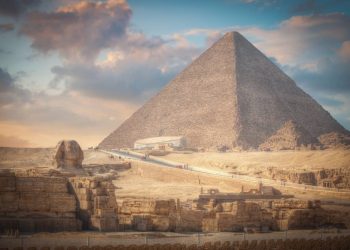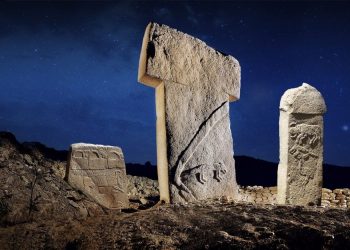How the ancients constructed the pyramids of Egypt remains one of the greatest archaeological enigmas in history. In fact, everything we think we know about the construction of the Egyptian pyramids is mostly based on archaeological guesswork. Many alternatives, often contradictory theories, have been proposed throughout the years, attempting to explain the construction techniques used to build the pyramids. Nonetheless, to this date, experts can’t agree on how the ancient builders managed to build the pyramids. Researchers cannot settle on whether the blocks were lifted somehow, dragged, or rolled in place.
What we know is that tens of thousands of builders are thought to have participated in the construction of one pyramid. Archeologist Miroslav Verner believes that pyramid-building labor was organized into a hierarchy where workers were divided based on their skills. That’s about everything we know; everything else is a lot of guessing.
One of the greatest mysteries concerning the construction of the pyramids is its planning.
How were the pyramids built?
Experts have suggested that the builders of the pyramids used the same method that had been used in previous, lesser construction in Egypt, where the main architect would lay out parts of the plan on the ground on a one-to-one scale. According to John Romer, “such a working diagram would also serve to generate the architecture of the pyramid with precision unmatched by any other means.”
The exact time needed to build the largest pyramid in Egypt — that of Khufu — has also been heavily debated. Experts cannot concur whether the pyramid was built in 10, 14, or 20 years. Although the Great Pyramid of Giza is the most fascinating pyramid ever built in Egypt, it continues to hide its most precious secrets. We have absolutely no evidence that can tell us when, why, or how it was built.
Architectural achievement
Although it is the ancient Egyptians’ greatest architectural achievement, not one ancient text has been found anywhere in Egypt that mentions the construction of the pyramid. Not one ancient writing, hieroglyph, dating back from 2,500 BC (when the pyramid is thought to have been built), has ever been found.
It is the most massive, impressive, and precise pyramid of Egypt ever built. Still, no one decided to write down anything related to the transportation of its massive stones, using what method it was so precisely aligned, and how the massive stones were lifted and put into place to create the pyramid. There’s nothing out there that tells us anything about the pyramid. And this is not just an isolated case with the Great Pyramid of Khufu. In fact, the same thing happens with all other massive pyramids of Egypt. Take, for another example, the Step Pyramid of Djoser.
The first pyramid
Thought to have been built around 4,700 years ago, the Step Pyramid’s completion at Saqqara marked a revolution in Egyptian architecture and monument building. The Step Pyramid was thought to have been built during the reign of King Djoser, marking the beginning of a pyramid-building fever in Egypt that would last for hundreds of years. The Step Pyramid of Saqqara was revolutionary because it was the earliest colossal stone building and the earliest large-scale cut-stone construction in Egypt. With a total volume of 330,400 cubic meters (11,667,966 cu ft), it was a monument that never before in Egypt’s history was attempted before.
A true behemoth
In fact, the entire pyramid complex was gigantic, covering around 15 ha (37 acres); it is about 2.5 times as large as the Old Kingdom town of Hierakonpolis. Not only was the Step Pyramid at Saqqara a revolutionary monument of unseen size, it changed future monument-building techniques in Egypt. Strangely, not one ancient text has been found anywhere in Egypt that mentions one single word about its construction.
No blueprints
We have an absolute lack of reports and documentation about the pyramid-building process, which raises several questions about the majestic structures’ history. And just as the first pyramid of Egypt lacks mention in Egyptian history, the same phenomenon occurs with pyramids that would be built in Egypt following the reign of Djoser. The next successful pyramid was built by Sneferu, a king of Egypt’s Fourth Dynasty, heralded as the greatest pyramid builder in Egypt’s history.
In fact, Sneferu is credited with building three pyramids in total. His first pyramid was the one at Meidum. It resulted in a mixture between a Step Pyramid and a smooth-sided one. Although the pyramid still stands to this day, it is badly damaged, with most of its stones having collapsed in antiquity.
It is believed that the pyramid builders experimented with the pyramid at Meidum, attempting to turn a Step Pyramid into a true, smooth-sided one. This was almost achieved in Sneferu’s second pyramid, the Bent Pyramid at Dahshur. This is one of the unique pyramids in Egypt because of its curious appearance, and it retains most of its outer casing stones.
Unprecedented
It was an unprecedented construction in Egypt, with a total volume of 1,237,040 cubic meters (43,685,655 cu ft). However, soon after, another pyramid would decorate the landscape at Dahshur, The Red Pyramid. This ancient structure, also thought to have been built by Sneferu, is the pyramid that is believed to have laid the foundations for constructing the Great Pyramid. It is Egypt’s third-largest pyramid and the first successful smooth-sided pyramid built in Egypt.
Curiously, just like the monuments that predate it, no ancient text has been found to mention how it was planned, designed, or built. But what if an ancient machine was used to build Egypt’s Pyramids?
Construction Methods Mentioned in 440 BC
Were machines used to build Egypt’s Pyramids? Strangely, the first-ever historical reference that has been found to mention something about the construction of the pyramid comes thousands of years after the pyramids were built, at a time when already in ancient Egypt, the pyramids were long-lost monuments built by their ancestors.
If we take a look at the writings of the father of history, the Greek philosopher, historian, and writer Herodotus, machines might have been used to build the pyramids. Herodotus explains this in his work “The Histories.”
Herodotus explains how the pyramids of Egypt were built with “machines” that (may have) helped the builders raise the massive stones into position;
The pyramid was built in steps, battlement-wise, as it is called, or, according to others, altar-wise. After laying the stones for the base, they raised the remaining stones to their places by means of machines formed of short wooden planks. The first machine raised them from the ground to the top of the first step. On this there was another machine, which received the stone upon its arrival and conveyed it to the second step, whence a third machine advanced it still higher. Either they had as many machines as there were steps in the pyramid, or possibly they had but a single machine, which, being easily moved, was transferred from tier to tier as the stone rose — both accounts are given and therefore I mention both. The upper portion of the Pyramid was finished first, then the middle and finally the part which was lowest and nearest to the ground.
No more references
No other reference has ever been found anywhere on Earth that mentions a machine, a technique, or methods by which Egypt’s pyramids were built. This is one of the greatest historical enigmas experts have been unable to answer. Interestingly, it is thought that Leonardo da Vinci drew the machine described by Herodotus, which may have been used by the ancient builders of the pyramid.
Join the discussion and participate in awesome giveaways in our mobile Telegram group. Join Curiosmos on Telegram Today. t.me/Curiosmos



